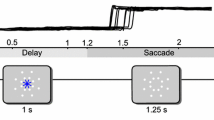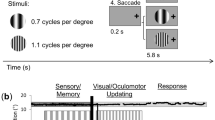Abstract.
We investigated the quantitative relationship between saccadic activity (as reflected in frequency of occurrence and amplitude of saccades) and blood oxygenation level dependent (BOLD) changes in the cerebral cortex using functional magnetic resonance imaging (fMRI). Furthermore, we investigated quantitative changes in cortical activity associated with qualitative changes in the saccade task for comparable levels of saccadic activity. All experiments required the simultaneous acquisition of eye movement and fMRI data. For this purpose we used a new high-resolution limbus-tracking technique for recording eye movements in the magnetic resonance tomograph. In the first two experimental series we varied both frequency and amplitude of saccade stimuli (target jumps). In the third series we varied task difficulty; subjects performed either pro-saccades or anti-saccades. The brain volume investigated comprised the frontal and supplementary eye fields, parietal as well as striate cortex, and the motion sensitive area of the parieto-occipital cortex. All these regions showed saccade-related BOLD responses. The responses in these regions were highly correlated with saccade frequency, indicating that repeated processing of saccades is integrated over time in the BOLD response. In contrast, there was no comparable BOLD change with variation of saccade amplitude. This finding speaks for a topological rather than activity-dependent coding of saccade amplitudes in most cortical regions. In the experiments comparing pro- vs anti-saccades we found higher BOLD activation in the "anti" task than in the "pro" task. A comparison of saccade parameters revealed that saccade frequency and cumulative amplitude were comparable between the two tasks, whereas reaction times were longer in the "anti" task than the pro task. The latter finding is taken to indicate a more demanding cortical processing in the "anti" task than the "pro" task, which could explain the observed difference in BOLD activation. We hold that a quantitative analysis of saccade parameters (especially saccade frequency and latency) is important for the interpretation of the BOLD changes observed with visual stimuli in fMRI.
Similar content being viewed by others
Author information
Authors and Affiliations
Additional information
Electronic Publication
Rights and permissions
About this article
Cite this article
Kimmig, .H., Greenlee, .M., Gondan, .M. et al. Relationship between saccadic eye movements and cortical activity as measured by fMRI: quantitative and qualitative aspects. Exp Brain Res 141, 184–194 (2001). https://doi.org/10.1007/s002210100844
Received:
Accepted:
Issue Date:
DOI: https://doi.org/10.1007/s002210100844




